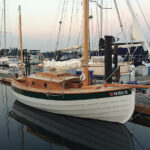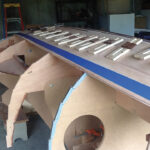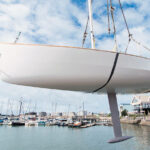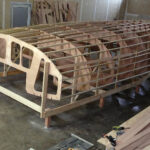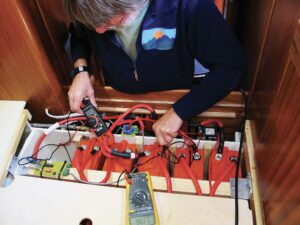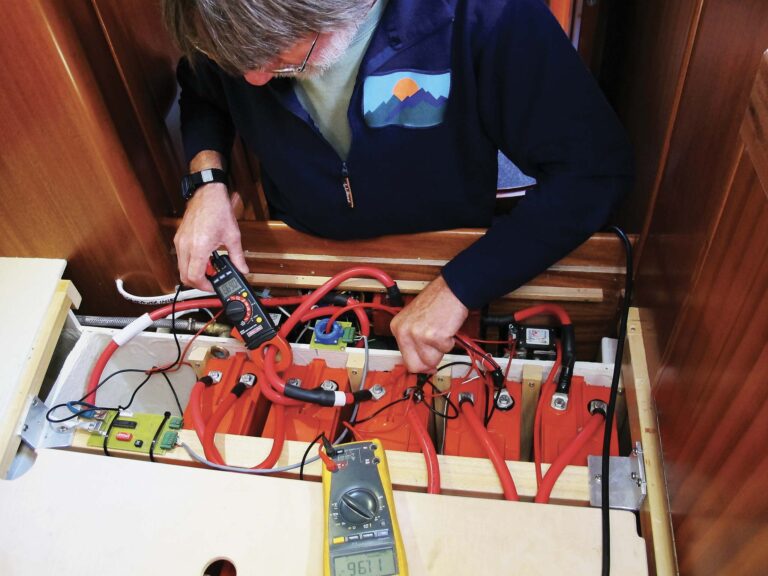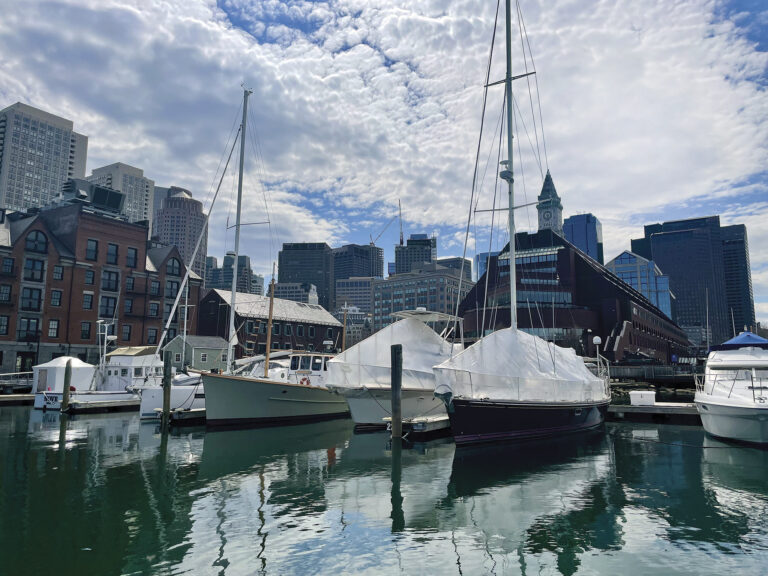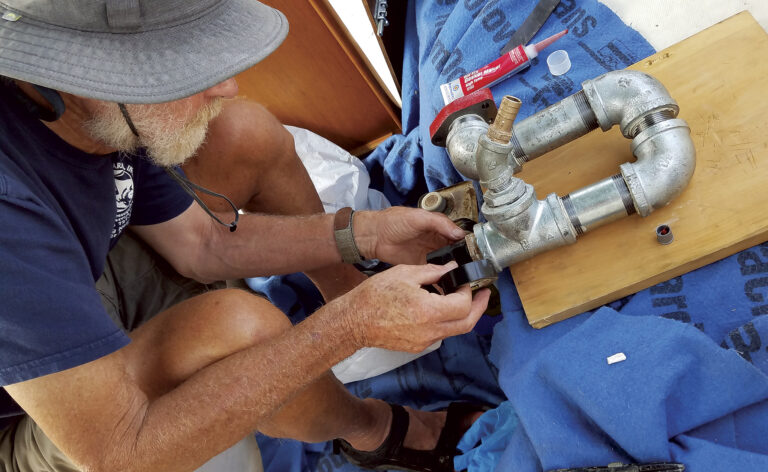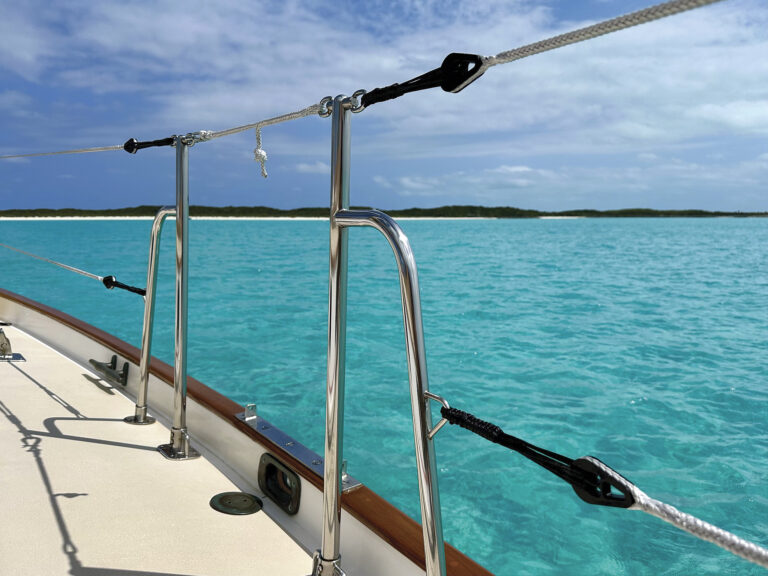
Not many events in life are as emotionally convoluted as when the plans for a sailboat arrive at the amateur builder’s home. The plans flutter out on the dining table and quickly there arise intertwining shivers of heady anticipation and well-founded fear. If there are 10 pages of plans promising breathtaking beauty, within them are 100 things the prospective boatbuilder does not know how to do, ranging from water-sealing the deck hardware to somehow turning a 25ft spruce mast. Beyond the technical issues, the awestruck amateur rightly wonders: Do I have the character—the perseverance, the capacity to surf the waves of elation and despair—for the year or three or 10 this magnificent creation will demand?
There’s never been a better time to find out. As many production builders have evaporated from the under-30ft class, a tide of professional designers and naval architects has flooded the void with sophisticated plans for amateur builders. Modern materials—plywood, fiberglass and epoxy—make it possible to build lightweight, rotproof and prodigiously strong composite hulls through several techniques, most of them simpler than traditional plank-on-frame. In just the last few years, many designers have also started producing kits consisting of a building jig and all the hull panels and bulkheads through the technology of CNC (computer numerical controlled) routing. The jig guarantees precise alignment, and the panels are perfectly cut to plan. This eliminates one of the amateur’s prime trepidations—birthing a twisted banana of a hull—and erases many hours of front-end labor.
That said, the logical and practical arguments against building your own are hard to beat back. There’s risk; not everyone who starts will finish. An inexperienced builder probably will not end up with a boat whose functional details are as well executed as those of a production boat that has undergone years of design refinement. It’s also no way to save money. A used fiberglass boat in decent condition can be found for a third to half the cost of parts and materials for a comparable home-built boat. For example, the 21ft gaff-rigged cutter I’m currently building will end up costing between $33,000 and $35,000, fully outfitted—several thousand dollars more than the new prices of a couple of popular fiberglass boats near the same size. And yes, since it’s wood, it will demand more maintenance.

I am a serial boatbuilder, however, with enough experience to know better if knowing better would enhance my life. This is my sixth build; preceding it have been three other sailboats and two kayaks. I never expected this would happen, but what started out as an experiment in building a complicated toy became a life-changing experience. So it is for many amateur builders.
WHERE TO START
With the dream, of course. And then whack it down to realistic scale. While there are inspirational stories like that of Roy Jackson of Bainbridge Island, Washington, an advertising executive who began building a 43ft schooner in 1976 and finally launched it in 2009, at the age of 78, there are many more where the overambitious dream ended as expensive firewood. It’s more prudent to start with a modest dinghy to both learn basic skills and test whether you have the perseverance to build a serious cruising boat.
Some designers post expected building times for various boats in their catalogs. These are, without exception, laughable. For an honest estimate, multiply by two or three. For the record, my first boat, a 13ft 6in sailing dinghy, required 419 hours. My second, a 19ft gaff sloop, consumed about 3,000. A friend in British Columbia took 6,000 hours for a meticulously crafted 23ft Bermuda sloop.
The amateur will be surprised to find how many different skills have to be learned to build a sailboat. It’s not just cutting and fitting wooden parts. For a composite hull, you also learn fiberglassing and filleting (sculpting coves of thickened epoxy to strengthen joints such as bulkhead-to-hull), and good fiberglassing is not easy. Do it sloppily, and you’ll incur three gruesome hours of extra fairing per foot of boatlength. Painting and varnishing are arts that take many boats’ worth of practice to rise above the backyard skill level. (Although it’s absolutely OK to go for a “workboat” finish.)
Then there’s rigging. When I arrived at this final step on my complicated gaffer Nil Desperandum I was lost in the woods—the plans provided little illumination—until I phoned Sam Devlin, the designer, and told him I was about to turn the job over to a professional. “He’ll charge you $5,000,” Devlin said. “You can figure it out.” And I did, faced with such a bulging estimate. I digested a book on rigging and spent days prowling marinas in the Seattle area, camera and notebook in hand, studying how boats in my size range were rigged. Finally, I visited a chandlery where an extraordinarily helpful associate combed through the plans with me for two hours, patiently advising which block, shackle, eye, cleat and line was appropriate for each job. It took a couple of seasons of sailing to fiddle the rig into top form and reliability, but it now works admirably—and I have only low-grade trepidation for rigging the next boat.
The step from dinghy to cruising boat is not to be taken lightly; new complexities present at every turn. How does one execute the corners of the trunk cabin? Garden-shed carpentry won’t do: these are prominent details featuring gracefully complicated curvy parts and “other-than-right angles.” My solution involved making mockup corner posts from scrap wood to angle the rabbets for the cabin sides correctly before reaching for the expensive mahogany. Taking this extra step cut against the grain of my impatient nature, which was another benefit of doing it: vocational rehab in learning patient and methodical work.
Steve Stromborg built Marianita, a gaff yawl designed by Lain Oughtred
The author sails Nil Desperandum, his Sam Devlin-designed, home-built gaffer
Homemade clamps await the next plank on John Hartmann’s Ilur
GOOD REASONS FOR DOING IT
Browsing the online plan catalogs is like navigating the world’s largest sailboat show, one that takes place in an alternate universe where the economics of the industry actually favor modest size and creative variety. For example, if your dream is a compact cruiser in the 19ft to 22ft range, the designers listed in the sidebar offer 30 different options, including Bermuda sloops, gaff sloops, yawls, catboats, a cat-ketch and even a trailerable schooner.
Construction regimes include traditional plank-on-frame, plywood stitch-and-glue, plywood lapstrake and cold-molding. I have built hulls using various methods, and in my opinion, stitch-and-glue is the most amateur-friendly. Its only drawback is that seriously curvaceous shapes are not possible, and some designs—certainly not all—look a bit slab-sided. The most beautiful small boats may be lapstrake: the parallel flow of sweeping lines creates a visual rhythm that makes the boat seem like an organic creation.
Although some designers bitch and moan about amateurs’ irrepressible urges to tweak their plans, building your own allows personalization that would be impossible in a production boat. I thought it prudent, for example, to build positive flotation into Nil Desperandum, so I turned 14 cubic feet of hull crannies into watertight air compartments, providing 900lb of flotation to counter the 650lb of ballast. Devlin approved my scheme and even offered helpful advice; it’s sensible to ask.
Even a modest daysailer will force you to surf a cycle of elation and discouragement. And if you are to keep going, you have to figure out a way to manage it, building a reservoir of perseverance that may seep into other areas of your life. You learn that perfectionism is not your friend, so you let go of the vision of uncompromised beauty you held when you first spread out the plans on the dining room table. Oddly enough, this surrender will also make you happier, as you learn to separate the tasks that must be done right from those merely built as a projection of ego. You will gain confidence in yourself at the same time you plumb new depths of humility. You will be startled to find that these two qualities don’t contradict each other.
Boats built from plans or kits have their own individuality
And the finished project, an oceangoing 30-footer, meets the water
Here is a Didi 9.5 plywood kit boat from Dix Design in build
EXEMPLARY AMATEURS
John Hartmann’s 14ft 6in daysailer Waxwing, which he built to the “Ilur” design by French naval architect Francois Vivier, is a fetching refutation of my claim back at the beginning: that an amateur-built boat probably won’t match the execution of a production craft. The detailing of Waxwing would blow any competition out of the water. The oars, for example, stash elegantly under the floorboards. A mizzen, complementing the balanced lugsail, makes sail balance and heaving-to easy. The mizzen sheet, in an exquisite innovation, runs through a hollow boomkin that Hartmann devised.
Waxwing illustrates another of the advantages of home building: production manufacturers rarely try to incorporate tricky, difficult-to-execute details in small boats because they would inflate the price beyond the market’s tolerance. Amateur builders can enjoy very finely detailed small craft that simply isn’t available commercially—if they have the patience and chops for the work.
Hartmann, 59, lives in central Vermont and works as an emergency physician. “Our modern work lives, whether you’re a stock trader or a physician, are dictated by deluges of information,” he says. “That deluge takes us away from processing information at a human scale. Making things with your hands is evolutionarily human-scaled, and that’s a really important counterpoint to my work life.”
It took 11 months of steady off-hours work to build the boat, starting with a kit for the hull. He commissioned Vivier to draw the mizzen—heretofore the Ilur featured a single lugsail with optional jib—and undertook extra ambitions such as designing a bronze mainmast collar for a local foundry to cast. Still, he wasn’t trying to create a work of art, a boat so finely finished that a scratch at the dock would ruin the day. He says his goal was to honor the Ilur’s workboat roots on the 19th-century Breton coast, while yet building a pleasure boat nice enough to be proud of.
“It’s such a capable boat,” Hartmann says. “It’s a boat to which people respond warmly. And I’ve learned I can trust it in circumstances wherein the wrong boat we’d be in serious trouble. I give Vivier all the credit.”
Steve Stromberg, a 52-year-old firefighter from Bainbridge Island, Washington, is another serial boatbuilder with half-dozen sailboats and kayaks behind him. For the last two, pure beauty drove his choices: a 14ft Deer Isle Koster by Maine designer Clint Chase and a 19ft Eun Na Mara by Iain Oughtred. Each of Stromborg’s boats, beginning with a Pygmy kayak kit—the “gateway drug in boatbuilding,” he says—has been a step up in complexity. He seems to have an innate need to keep raising the stakes, challenging himself more with each boat. The next one, he says, will be the 24ft Fenwick Williams gaff yawl, a 9,000lb, plank-on-frame cruising boat.
What has he gotten out of building boats? “I’ve met a lot of great people. It’s kept me from restoring another car. The act of massaging wood into a functioning boat is my form of meditation. To avoid PTSI, firefighters need something that absorbs us outside of work, and it’s given me that outlet. I’ve created a number of pretty things that have the potential to last beyond my short life, and that’s very satisfying.”
Amateur boatbuilders sometimes find it difficult to put into words, but most of us have found that in various ways, the boats build us. This isn’t like crafting planters or furniture. A woodworker’s pride may pivot on a coffee table, but human lives depend on boats. We build patience and focus and character through the vital tasks that involve their structure and seaworthiness. Character can be simply defined as the ability to discern right from wrong, and choosing to do right even when nobody’s watching. Building a boat is replete with those choices, and making them faithfully is like exercising a muscle. Keep that muscle healthy, and it’s in shape for the difficult tests in every other corner of life.
PLANS AND KITS
Atkin & Co. atkinboatplans.com
B&B Yacht Designs bandbyachtdesigns.com
Brooks Boats Designs brooksboatsdesigns.com
Chase Small Craft chase-small-craft.com
Chesapeake Light Craft clcboats.com
Chesapeake Marine Design cmdboats.com
Devlin Designing Boat Builders devlinboat.com
Dudley Dix Yacht Design dixdesign.com
Farrier Marine f-boat.com
Francois Vivier, naval architect (English language website) vivierboats.com/en
Glen-L Marine Designs glen-l.com
John Welsford boat designs jwboatdesigns.co.nz
Iain Oughtred woodenboatstore.com/category/oughtred_designs
Paul Gartside Boatbuilder and Designer gartsideboats.com
OTHER RESOURCES
Off Center Harbor is a video subscription service with a wide-ranging library of professionally produced videos on specific wooden boats, boat handling and seamanship, and technical how-to’s: offcenterharbor.com
The Wooden Boat Forum includes illustrated builders’ blogs and questions and advice on every imaginable aspect of modern and traditional boatbuilding: forum.woodenboat.com
Lawrence Cheek is a journalist and sailor from Whidbey Island, Washington. He is just about to complete the trunk cabin of his sixth boat
August 2018

